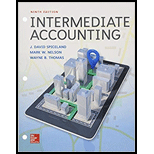
Expected
• LO13–6
The Heinrich Tire Company recalled a tire in its subcompact line in December 2018. Costs associated with the recall were originally thought to approximate $50 million. Now, though, while management feels it is probable the company will incur substantial costs, all discussions indicate that $50 million is an excessive amount. Based on prior recalls in the industry, management has provided the following probability distribution for the potential loss:
| Loss Amount | Probability |
| $40 million | 20% |
| $30 million | 50% |
| $20 million | 30% |
An arrangement with a consortium of distributors requires that all recall costs be settled at the end of 2019. The risk-free rate of interest is 5%.
Required:
1. By the traditional approach to measuring loss contingencies, what amount would Heinrich record at the end of 2018 for the loss and
2. For the remainder of this problem, apply the expected cash flow approach of SFAC No. 7. Estimate Heinrich’s liability at the end of the 2018 fiscal year.
3. Prepare the
4. Prepare the journal entry to accrue interest on the liability at the end of 2019.
5. Prepare the journal entry to pay the liability at the end of 2019, assuming the actual cost is $31 million. Heinrich records an additional loss if the actual costs are higher or a gain if the costs are lower.
(1)
Contingent Liability
Contingent liability is one form of liability that arises based on a particular outcome of a specific event. They are possible obligation that might arise or might not arise based on the future events. It is otherwise called as probable liability or eventual liability. Following are examples of contingencies:
- Income tax disputes
- Discounted notes receivable
- Lawsuits
- Debt guarantees
- Failure to follow government regulations
To measure: Contingent liability through traditional approach
Explanation of Solution
As per traditional approach, H accrues more likely amount and it does not exceed probability of 50%. Here, at the end of the year 2017, Company H records loss and contingent liability amounting to $30 million based on probability of 50%.
(2)
To calculate: The amount H’s liability at end of the year 2018 fiscal year by applying the expected cash flow approach.
Explanation of Solution
H’s liability (and loss) at the end of 2018 is determined by multiplying loss amount and probability with present value factor. The Present value of an ordinary annuity of $1 for 1 period at 5% is 0.95238 and refer Table 4 in Appendix).
(3)
To prepare: Journal entry to record the contingent liability (and loss).
Explanation of Solution
| Date | Accounts and Explanation | Post Ref | Debit ($) | Credit ($) | |||
| 2018 | Loss (E–) | 27,619,020 | |||||
| December | 31 | ||||||
| Estimated liability (L+) | 27,619,020 | ||||||
| (To record contingent liabilities) | |||||||
In order to record the contingent liabilities, Loss and estimated liability accounts are affected. Loss decreases the value of equity, and thus debit, loss account by $27,619,020. Estimated liability increases the liability account. Thus, credit estimated liability account by $27,619,020.
(4)
To Prepare: Journal entry to accrue interest on the liability at the end of 2019.
Explanation of Solution
| Date | Accounts and Explanation | Post Ref | Debit ($) | Credit ($) | |||
| 2019 | Interest Expense (E–) | 1,380,980 | |||||
| December | 31 | ||||||
| Estimated liability (L+) | 1,380,980 | ||||||
| (To record contingent liabilities) | |||||||
In order to record the contingent liabilities, Interest expense and estimated liability accounts are affected. Interest expense decreases the value of equity and thus, debit Interest expense account by $1,380,980. Estimated liability increases the liability account. Thus, credit estimated liability account by $1,380,980. Working note for determining amount of interest expense is as follows:
(5)
To prepare: Journal entry to pay the liability at the end of 2019.
Explanation of Solution
| Date | Accounts and Explanation | Post Ref | Debit ($) | Credit ($) | |||
| 2019 | Liability (L–) | 29,000,000 | |||||
| December | 31 | ||||||
| Loss (E–) | 2,000,000 | ||||||
| Cash (A–) | 31,000,000 | ||||||
| (To record contingent liabilities) | |||||||
When contingent liability is recorded,liability is decreased and thus, debit liability account by $29,000,000. Loss decreases the value of equity and thus, debit loss account by $2,000,000. Cash is an asset account and it decreases by $31,000,000. Thus, credit Cash account with $31,000,000.
Working notes below to determine the amount of loss is as below:
Want to see more full solutions like this?
Chapter 13 Solutions
INTERMEDIATE ACCOUNTING(LL)-W/CONNECT
- I need help finding the accurate solution to this financial accounting problem with valid methods.arrow_forwardPlease provide the accurate answer to this general accounting problem using appropriate methods.arrow_forwardI am trying to find the accurate solution to this general accounting problem with the correct explanation.arrow_forward
- Please help me solve this general accounting question using the right accounting principles.arrow_forwardCan you solve this general accounting problem using accurate calculation methods?arrow_forwardPlease provide the solution to this general accounting question with accurate financial calculations.arrow_forward
 Intermediate Accounting: Reporting And AnalysisAccountingISBN:9781337788281Author:James M. Wahlen, Jefferson P. Jones, Donald PagachPublisher:Cengage Learning
Intermediate Accounting: Reporting And AnalysisAccountingISBN:9781337788281Author:James M. Wahlen, Jefferson P. Jones, Donald PagachPublisher:Cengage Learning
